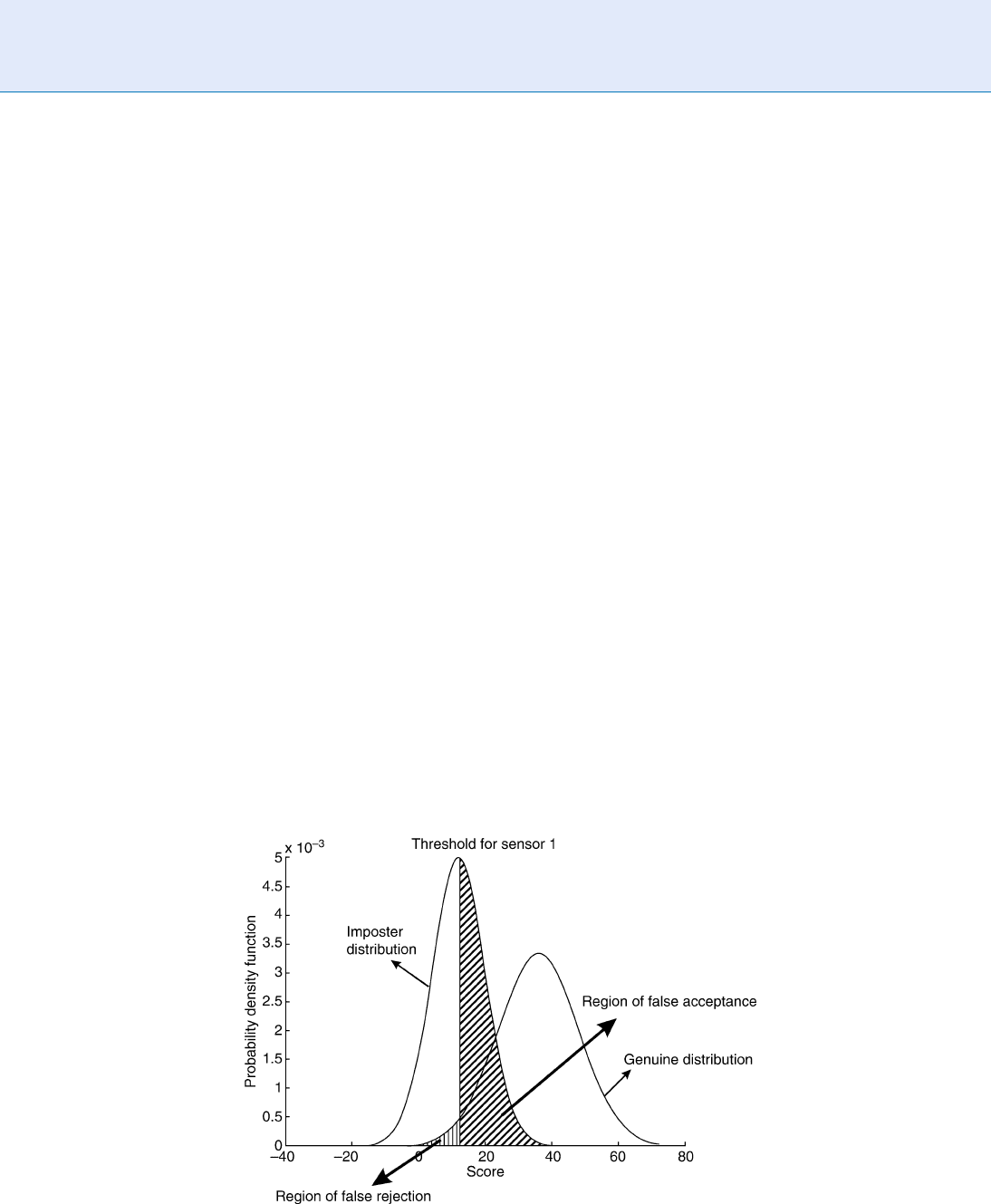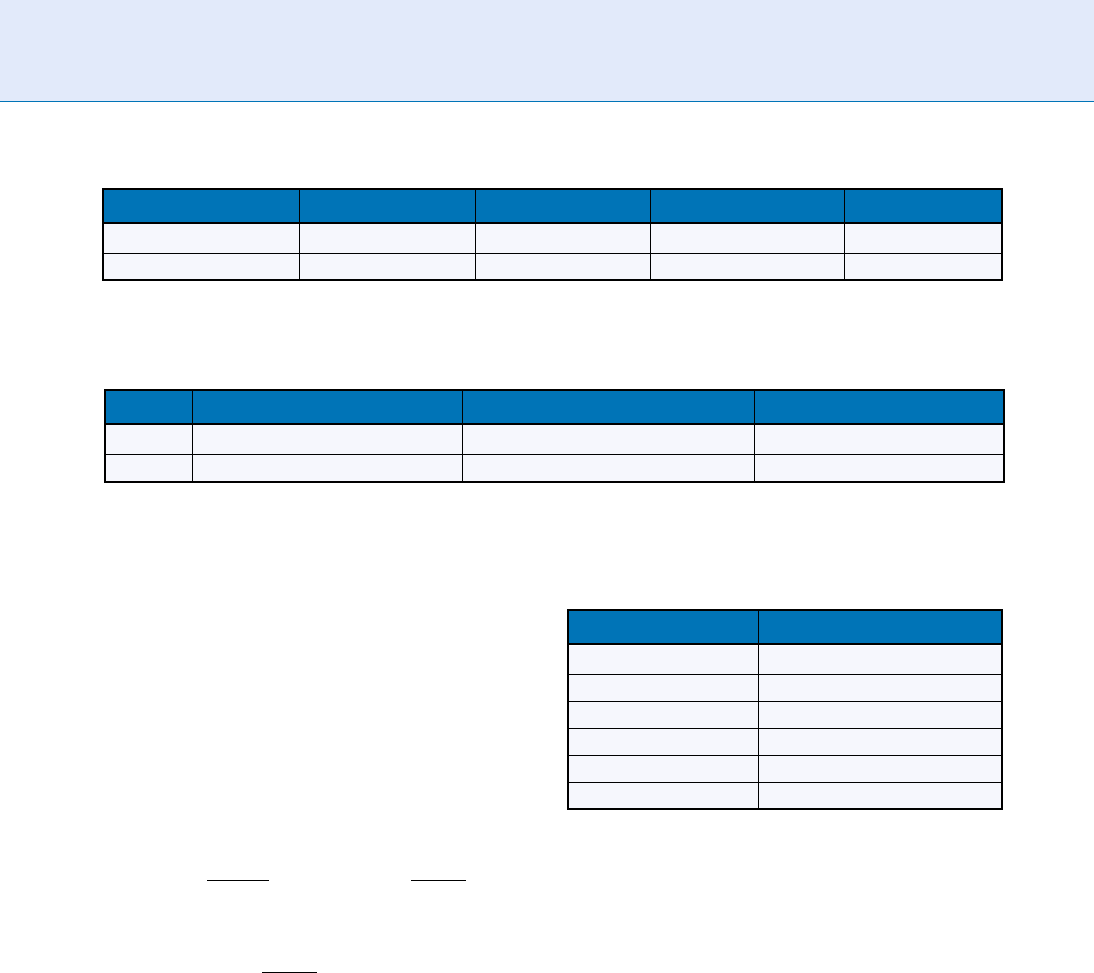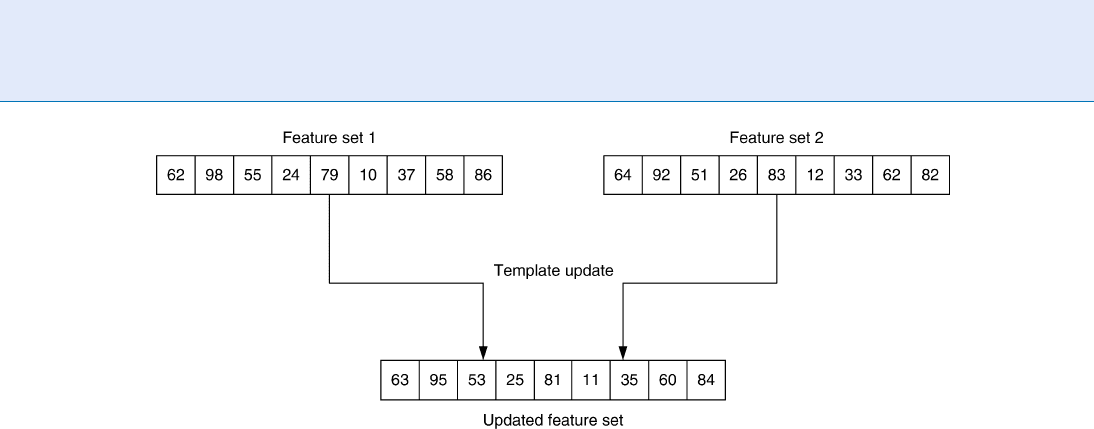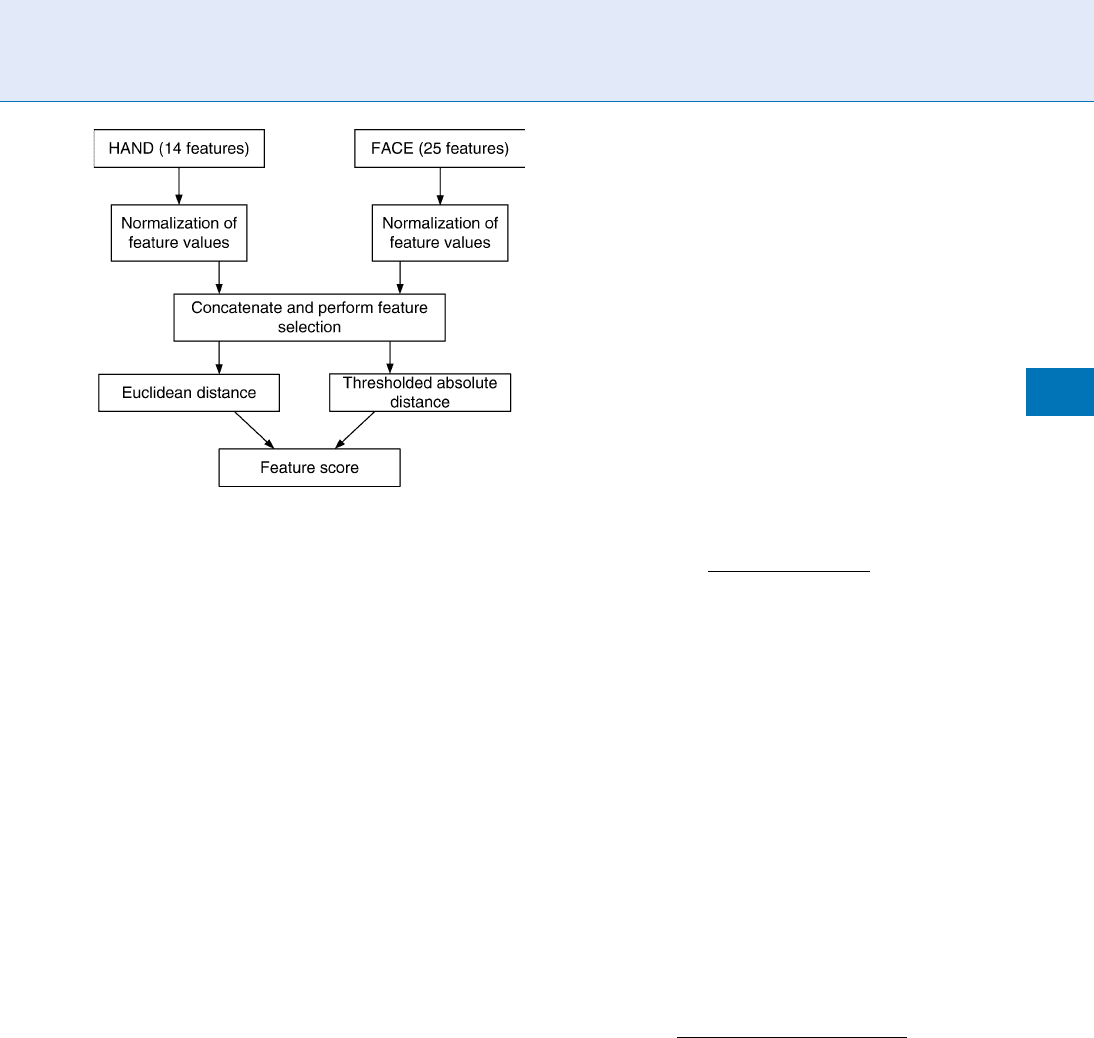Li S.Z., Jain A.K. (eds.) Encyclopedia of Biometrics
Подождите немного. Документ загружается.


To provide a little more balance between conve-
nience and security, a multimodal system could still
be employed, but only with one or two randomly
selected biometric modalities required for authentica-
tion/identification. Variations could also be introduced
within a single modality (e.g., requiring submission of
a right index finger, one day, and submission of a left
thumb on the nex t day).
The authentication/identification systems could also
be designed to issue randomized as well as cued
challenges – even if the original submission would
otherwise have been acceptable. At the very least, this
implementation w ould provide the opportunity to ob-
tain two biometric samples. Where the samples are un-
usually similar , extra caution might be merited in case a
spoof is involv ed, as the likelihood that a person will be as
infallible as to place their biometric so consistently is slim.
Finally, biometric systems can be deployed and
designed so as to focus on internal or subcutaneous
characteristics that are generally much more difficult
to capture surreptitiously, as well as to forge or modify.
Biometrics and Fraud: Looking
to the Future
While a lot of focus has been placed on the design and
utilization of biometrics to deter, inhibit, and –
to a lesser degree – mitigate non-biometric fraud,
comparatively little attention has been paid to the con-
sequences and implications when fraudsters are success-
ful in compromising biometric data. Because biometric
characteristics are so intrinsic and relatively immutable,
this is an issue of particular concern that can impact the
successful deployment of the technologies.
Cancelable/Changeable Biometrics
To address concern over the immutability of bio-
metrics, research has been conducted by entities like
IBM and the Korean Biometrics Engineering Research
Center into cancellable biometrics, also known as
changeable biometrics. The high-level concept of such
research has been to look into altering biometric data
that is captured before it is actually fully processed and
stored in template form. In this way, a compromised
biometric can theoretically be revoked and a new algo-
rithm can generate a novel distortion of the affected
individual’s biometric characteristic – essentially giving
them a new biometric.
However, one should keep in mind that if a fraud-
ster is able to get hold of the original source biometric
characteristic (or an equivalent spoof), this approach
would not suffice, as the fraudster would then still be
able to regenerate a new cancelable/changeable bio-
metric characteristic just as easily as the legitimate
bearer of the original source biometric.
Nominal Identities Versus Biometric
Identities
As biometric systems increasingly protect sensitive
data and items or access privileges of high value, the
incentive fraudulent activity to exploit them will also
increase. And at some point, as the case has been with
virtually every major security technology in the past,
biometric data w ill be compromised.
One of the important ways in which the impact of
such compromise can be mitigated is to sever, when-
ever feasible and reasonable, the connection between
Examples of liveness detection methods for five established biometric modalities include:
Fingerprint Face Iris Hand geometry Voice recognition
Spectroscopic
analysis
Reactivity to Cues,
Commands, and stimuli
(e.g., – blinking)
Photonic and
spectrographic
analysis
Required contact with
specifically- placed
prongs
Recitation of
randomly generated
passphrases
Temporal
variation in
perspiration
Reactivity to stimuli
(e.g., – pupil
dilation)
Ink/Dye detection
Timestamping and
byte scrambling
590
F
Fraud Reduction, Overview

an indiv idual’s nominal identity and their biometric
identity. If, for instance, a deployment merely
requires a de termination as to whether a given indi-
vidual, represented by their biometric characteristics,
should be granted access to a given secure location,
then there is no need to link permanently the indiv i-
dual’s name and background information to their
biometric data after an initial background check has
been conducted.
Whereas names have often served as proxies for
trustworthiness or transactional histories, biometrics
can now serve this purpose going forward. With
biometrics there is also the possibility of selecting dif-
ferent biometric aspects for accreditation or validation
given each distinct application or deployment. A sing le
biometric characteristic, thus, has the flexibility to serve
in a variety of functions that process that biometric
differently – without making that biometric into a
universal identifier rife with the problems of overuse
that have plagued the US social security number.
In the scenario described above, if a fraudster com-
promises one biometric system, the damage is miti-
gated insofar as other systems and deployments may
still be protected, in addition to sensitive and private
information tied to one’s nomi nal identity.
Valuing Biometric Data
One of the remaining challenges with respect to
biometrics and fraud is the determination of how to
value biome tric data. This is especially important as
fraudsters increasingly target not just data protected by
biometrics, but biometric data, itself.
Traditionally, items have been valued based on
three factors:
Scarcity
Uniqueness
Demand
With biometrics, however, such a framework for asses-
sing value is of little use: virtually each and every given
biometric characteristic is inherently distinct (if not
unique), scarce, and of high demand for both the
possessor and potential imposters/fraudsters. It
would seem, therefore, that all biometric characteris-
tics should be deemed priceless or at least assigned
extremely lofty values.
However, this would be impractical in an age of risk
calculations and need by insurance companies, govern-
ments, and other entities realistically to quantify the
impact and cost of fraud. Therefore, valuation of a
biometric is best conducted according to a different
set of three factors:
Value of the Biometrically-Protected Item or Privilege
Range of Utility
Spoofabilit y
In addition, whenever a biometric system is designed,
careful consideration needs to be taken as to whether
templates or images should be used. Generally, images
will be more valuable from perspectives concerned
with forensics, interoperability, and scalability.
Templates, however, will be more desirable from an
identity-protecting perspective. Thus, from a fraud
reduction perspective, the guiding principle should
be that templates, which are more limited than images,
normally, should be employed whenever possible in
lieu of images. To achieve this balance, a negative
incentive should be implemented such that there will
be stiffer legal penalties for compromised biometric
image data versus biometric template data.
Related Entries
▶ Asset Protection
▶ Binding of Biometric and User Data
▶ Biometric Encryption
▶ Consumer Recognition
▶ Forgery Sign
▶ Fraud Reduction, Applications
▶ Liveness and Anti-Spoofing
▶ Spoofing
▶ Time and Attendance
References
1. Study Report on Biometrics and E-Authentication. INCITS/M1
Ad Hoc Group on Biometrics in E-Authentication (2006)
2. Anderson, K.: Consumer Fraud in the United States: Second
Survey. Federal Trade Commission, Washington, DC (2007)
3. Lee, V. et al.:Transcript of Authentication Technologies FTC
Proof Positive Workshop Session. Federal Trade Commission,
Washington, DC (2007)
Fraud Reduction, Overview
F
591
F

4. Fraud and Error in the Benefit System: October 2006 to
September 2007. UK Department for Work and Pensions, Infor-
mation Directorate (May 2008)
5. Progress in Tackling Benefit Fraud: Thirty-first Report of Session
2007–2008. UK House of Commons, Committee of Public
Accounts (2 June 2008)
6. Counting the cost of UK fraud, BBC News, 24 November 2005.
http://news.bbc.co.uk/1/hi/business/4463132.stm (29 September
2008)
7. Woolcock, N.: Cost of fraud spirals to £40bn, TimesOnline,
9 September 2006. http://www.timesonline.co.uk/tol/news/uk/
article633540.ece (29 September 2008)
8. Ratha, N. et al.: Cancelable Biometrics: A Case Study in Finger-
prints (2006)
9. Unisys. Consumers Worldwide Overwhelmingly Support
Biometrics for Identity Verification, 26 April 2006. Press release
(30 September 2008)
10. Use of Biometric Identification Technology to Reduce Fraud
in the Food Stamp Program, United States Department of
Agriculture, Food and Nutrition Service, December 1999.
http://www.fns.usda.gov/oane/MENU/Published/fsp/FILES/
ProgramIntegrity/biomeval.htm (30 September 2008)
11. Identity Fraud: Prevalence and Links to Alien Illegal Activities,
United State General Accounting Office, 25 June 2002. http://
www.gao.gov/new.items/d02830t.pdf (30 September 2008)
12. Martinez-Diaz, M. et al.: Hill-Climbing and Brute-Force
Attacks on Biometric S ystems: A Case Study in Match-on-Car d
Fingerprint Verification, http://fierrez.ii.uam.es/docs/2006_
ICCST_HillClimbingAttackMoC_Martinez.pdf (30 September
2008)
13. Schuckers, S. et al.: Issues for Liveness Detection in Biometrics.
http://www.biometrics. org/html/bc2002_sept_program/2_
bc0130_DerakhshabiBrief.pdf (30 September 2008)
Freeman Chain Code (FCC)
Freeman Chain Code (FCC) is a compact method
for representing the contours of an object, first made
popular by Herbert Freeman.
▶ Hand Data Interchange Format, Standardization
Function Creep
This refers to the use of data beyond the purposes
originally intended at the time of data collection. For
biometrics, this usually means using the data for
purposs other than identification, as when a face
image is used to determine gender or ethnicity.
▶ Privacy Issues
Fundamental Frequency,
Pitch, F0
The fundamental frequen cy or F0 is the frequency at
which vocal chords vibrate in voiced sounds. This
frequency can be identified in the sound produced,
which presents quasi -periodicity, the pitch period
being the fundamental period of the signal (the inverse
of the fundamental frequency). Pitch is more often
used to refer to how the fundamental frequency is
perceived.
▶ Speech Analysis
Fusion Network Topology
The network architecture including sensors, commu-
nication channels, and fusion processing. The fusion
processing may be distributed due to physical con-
straints in the system. If a communication channel
between two sensors is long, it may be beneficial to
fuse all the sensors at one end of the channel so that
only the single fused decision is sent through the
channel. The topology is directly impacted by the
physical layout of the sensor network.
▶ Fusion, Decision Level
Fusion, Biometric
See Multi-biometrics.
▶ Biometric Algorithms
▶ Multibiometrics and Data Fusion Standardization
▶ Multiple Experts
592
F
Freeman Chain Code (FCC)

Fusion, Confidence Level
▶ Fusion, Score-Level
Fusion, Data Level
▶ Fusion, Sensor-Level
Fusion, Decision-Level
LISA OSADCIW,KALYAN VEERAMACHANENI
Syracuse University, Syracuse, NY, USA
Synonyms
Distributed detection; Distributed inference making;
Multiple classifier fusion; Statistical signal processing
Definition
Decision level fusion falls under a broader area known
as distributed detection systems and is the process of
selecting one hypothesis from multiple M hypotheses
given the decisions of multiple N sensors in the presence
of noise and interference. In biometrics, decision level
fusion creates a single decision from typically two
hypotheses, imposter or genuine user, from multiple bio-
metric sensor decisions, which may or may not be identi-
cal sensors. Often, decision leve l fusion is implemented to
save communication bandwidth as well as improv e deci-
sion accuracy. A statistical performanc e model for each
biometric sensor is needed a priori to support the system
wide optimization in terms of two error rates: false accep-
tance rate, admitting an imposter, and false rejection rate,
rejecting the genuine user. A weighted sum of these two
errors is a useful objective function. This provides the
designer with the flexibility to weigh one error more than
the other error. Decision lev el fusion may be done at one
proce ssor, centrally, or at multiple processors, distributed.
Introduction
In biometric decision level fusion, the biometric sensors
send their final decisions through a communication
network that finally fuses these decisions at a fusion
center. Optimal decision fusion theory can be applied
to these problems. In distributed detection systems, the
number of decisions a sensor can make varies as well as
the
▶ fusion network topology. It may be more advan-
tageous to fuse a few sensors at a local node before
transmitting the information over a long distance to
the final fusion processor [1]. This complicates the
fusion problem by introducing different fusion net-
work topologies. Decision level fusion remains at the
foundation of the problem, however.
The decision level fusion problem in the biometric
area is typically one in identifying the user as a genuine
user or an imposter with the final decision made by a
central fusion processor [2–5]. This is referred to as a
▶ parallel fusion network. The advantages of fusion are
twofold. The first advantage is a more accurate final
decision by using multimodal, multiple and diverse,
biometric sensors, which provide significantly more
information to base a decision. Secondly, communica-
tion bandwidth needs, which are great as more sens ors
are networked, remain relatively constant if the deci-
sions instead of the full observation or measurement
are communicated.
The fusion accuracy of the sensor decisions relies
on the accuracy of the statistical models for the sensors
and an optimally designed fusion rule. The biometric
verification problem may be posed as a
▶ binary
hypothesis testing problem with the match score(s)
serving as observations. The two hypotheses are
H
0
: Imposter Identified and
H
1
: Genuine User Identified
Probability of false alarm,
P
FA
¼ Pðu ¼ 1jH
0
Þð1Þ
and probability of false rejection,
P
FR
¼ Pðu ¼ 0jH
1
Þð2Þ
In the Bayesian formulation, these two errors are
weighted by costs and summed into a single cost func-
tion called the Bayesian risk function. The Bayesian
risk function is
R ¼ PðH
0
ÞC
FA
P
FA
þ PðH
1
ÞC
FR
P
FR
; ð3Þ
Fusion, Decision-Level
F
593
F

where PðH
0
Þ, a priori probability of an imposters,
PðH
1
Þ a priori probability of a genuine user C
FA
, cost
of false acceptance, and C
FR
, cost of false rejection. In
the worst-case scenario, one assumes equal a priori
probabilities. Thus, we get
R ¼ C
FA
P
FA
þ C
FR
P
FR
: ð4Þ
We can rewrite Eq. 4, using a single cost factor by
replacing the cost of false acceptance by
C
FA
¼ 2 C
FR
: ð5Þ
This simplifies the problem to one design parameter to
optimize if the a priori probabilities of genuine users
and imposters are assumed to be fixed.
Decision Level Fusion with Single Bit
Information
Often Gaussian distribution functions are used as the
statistical sensor models for a binary hypothesis problem.
Each sensor has a different Gaussian distribution func-
tion as shown in Fig. 1 for each hypothesis: genuine user
and imposter. Higher observation values are t ypically
associated with a positive user identification or the
genuine user hypothesis. This leads to the distribution
on the right side of the plot in Fig. 1. The imposter has a
lower mean. Sensor 1 must measure a score that exceeds
a threshold for comparison purpose to decide if it has the
genuine user . The error rates are simply the areas under
the distribution corresponding to the opposite hypothe-
sis or wrong side of the threshold. False acceptance
probability is the area to the right of the threshold
under the imposter distribution. False rejection proba-
bility is the area to the left of the threshold under the
genuine user distribution. A single bit of 1 denotes that
the user is detected while the 0 is for the imposter [7].
The threshold divides the entire decision region
into region of acceptance and region of rejection. If a
user’s matching score happens to fall above the thresh-
olds, he/she is considered as genuine. If the user’s
matching score falls below threshold he/she is consid-
ered as imposte r [1, 2, 5, 6]. This process using the
threshold, l
i
, for sensor i is given by
u
i
¼
1; y
i
>¼ l
i
0; y
i
< l
i
8i ð6Þ
Let ½u¼ u
1
; u
2
; ...; u
n
½, be the combine d vector
of decisions represented by 1s and 0s for all the
sensors. T hese decisions are combined using a fusion
rule of
u
f
¼ f ð½uÞ: ð7Þ
The complete set of fusion rules for the 2-sensor case is
given in Table 1 [1]. There are 16 possible rules
for 2 sensors or (2
2
)
N
with N sensors as 2. The fusion
rule can be written as a 4-bit vector, where each
bit represents the final fused decision given the
Fusion, Decision-Level. Figure 1 Illustration of thresholding process, Decision Regions, and Error Regions, for given
Gaussian conditional density functions.
594
F
Fusion, Decision-Level

sensor decisions, [u
1
u
2
]. Since, there are two hypo-
theses, the fusion rules are bas ed on Boolean logic.
For example, in Table 1, f
2
is a rule based on AND
logic. The final decision is ‘‘1’’ only when both the
sensors say ‘‘1’’ and is ‘‘0’’ otherwise. Similarly, f
9
is
‘‘NAND’’, and f
8
is ‘‘OR’’.
For 3 sensors, there are 8 possible vectors requiring
a fused decision. Hence, the fusion rule is 8 bits long,
and the number of possible fusion rules for this prob-
lem is (2
2
)
3
or 64 rules for 3 sensors.
The error probabilities as in Eqs. 1 and 2 for the
entire system after fusion is estimated using
GP
FA
¼
X
½u
Pðu
f
¼ 1j½u; H
0
ÞPð½ujH
0
Þ: ð8Þ
Assuming independence, Eq. 8 can be calculated using
the statistical models and
GP
FA
¼
X
½u
Pðu
f
¼ 1j½u; H
0
Þ
Y
n
i¼1
Pðu
i
jH
0
Þ
¼
X
½u
Pðu
f
¼ 1j½u; H
1
Þ
Y
n
i¼1
ð
y
i
Pðy
i
jH
0
Þdy
i
ð9Þ
In case of correlation [8], however, the product dis-
appears resulting in a multivariate integral or
¼
X
½u
Pðu
f
¼1j½u;H
0
Þ
ð
y
1
ð
y
2
ð
y
n
f
Y
1
;Y
2
;:Y
n
0
B
@
ðy
1
;y
2
;...;y
n
jH
0
Þdy
1
dy
2
;...;dy
n
1
C
A
ð10Þ
Similarly,
GP
FR
¼
X
½u
Pðu
f
¼0j½u;H
1
ÞPð½ujH
1
Þ: ð11Þ
Assuming independence, (11) can be calculated
using
GP
FR
¼
X
½u
Pðu
f
¼0j½u;H
1
Þ
Y
n
i¼1
Pðu
i
jH
1
Þ: ð12Þ
In case of correlation, the multivariate integral arises as
before giving
¼
X
½u
Pðu
f
¼0j½u;H
1
Þ
ð
y
1
ð
y
2
ð
y
n
f
Y
1
;Y
2
;...;Y
n
0
B
@
ðy
1
;y
2
;...;y
n
jH
1
Þdy
1
dy
2
;...;dy
n
1
C
A
:
ð13Þ
This multivariate integral can only be calculated using
numerical methods. Since there are 2
N
combinations
of local decisions for N sensors, this integral must be
evaluated 2
N
1 times to estimate each error. This
operation can be ver y expensive computationally as
the number of sensors increases. An alternative is
using the Bahadur–Lazarfeld expansion, which enables
the estimation of the error probabilities using ‘‘n
1’’
evaluations of integrals [8].
The Bayesian risk function is now given by,
R ¼ P
0
C
10
Pðu
0
¼ 1j½u; H
0
ÞþP
1
C
01
Pðu
0
¼ 0j½u; H
1
Þ:
ð15Þ
Optimal Fusion Rule
For independent sens ors, however, the optimal fusion
rule is the
▶ likelihood ratio test [5]. For fixed thresh-
olds, the optimal fusion rule can be obtained by using
the likelihood ratio as in
Pðu
1
; u
2
; u
3
u
n
jH
1
Þ
Pðu
1
; u
2
; u
3
u
n
jH
0
Þ
u
0
¼ 1
>
<
u
0
¼ 0
P
0
ðC
10
C
00
Þ
P
1
ðC
01
C
11
Þ
:
ð16Þ
Fusion, Decision-Level. Table 1 All Possible Fusion Rules for 2 Sensors
u
1
u
2
f
1
f
2
f
3
f
4
f
5
f
6
f
7
f
8
f
9
f
10
f
11
f
12
f
13
f
14
f
15
f
16
00 0000000011 1 1 1 1 1 1
01 0000111100 0 0 1 1 1 1
10 0011001100 1 1 0 0 1 1
11 0101010101 0 1 0 1 0 1
Fusion, Decision-Level
F
595
F

Pðu
1
; u
2
; u
3
u
n
jH
h
Þ in (16) can be replaced by
Q
n
i¼1
Ð
y
i
Pðy
i
jH
h
Þdy
i
in case of independence or
Ð
y
1
Ð
y
2
Ð
y
n
f
Y
1
;Y
2
;...;Y
n
ðy
1
;y
2
;...;y
n
jH
h
Þdy
1
dy
2
;...;dy
n
in case of correlation. Optimal fusion rule can be
employed when the thresholds are fixed. The optimal
fusion rule as in Eq. 16 minimizes the Bayesian risk
function.
In the case of independence [5], the optimum rule
simplifies to
X
N
i¼1
u
i
log
1 F
FR
F
AR
þð1 u
i
Þlog
F
FR
1F
AR
u
f
¼ 1
>
<
u
f
¼ 0
log
C
FA
2C
FA
:
ð17Þ
Independent Pair of Biometric Sensors
Consider two sensors with conditional distributions
under both the hypotheses given by the familiar
Gaussian distribution. A Gaussian distribution is char-
acterized by N ðm; sÞ with a different mean, m, and
standard deviation, s, for each hypothesis as men-
tioned earlier. Table 2 gives the parameters of the
Gaussian distributions used for the 2 sensors in this
example. In Table 3, the threshold that achieves the
false alarm rate and false rejection rate given is speci-
fied for both sensors. Using these thresholds as well
as the error rates in the optimal fusion rule of Eq. 17,
we give the rules in the right column for the specified
costs in the left. Thus, different rules become optimum
as the error rates are weighted differently. If the sensor
is replaced with a more accurate biometric sensor, the
rule selection will change. Finally, if the sensors are
correlated, the original rule in Eq. 16 must be applied
and performance computed accordingly.
Related Entries
▶ Multiple Experts
References
1. Varshney, P.K.: Distributed Detection and Data Fusion, Springer.
Springer-Verlag, New York, Inc (1997)
Fusion, Decision-Level. Table 4 Optimal Fusion Rule
Under Assumption of Independence
CFA Optimal Fusion Rule
0.2 Majority Voting Rule
0.6 Majority Voting Rule
1 (1 OR 2) AND 3
1.2 (1 OR 2) AND 3
1.5 (1 OR 2) AND 3
1.9 (1 OR 2) AND 3
Fusion, Decision-Level. Table 3 Thresholds for the 3 Sensors for Single Bit Information
Sensor Threshold FAR FRR
1 95.945029260756 0.13409060569213 0.00007790554000
2 185.799498919171 0.01245661704014 0.00223574300430
Fusion, Decision Level. Table 2 Means and Standard Deviations of the Gaussian Distributions Under both the
Hypothesis for Different Sensors
Hypothesis/Paremeter H
0
/m
0
H
0
/s
0
H
1
/m
1
H
1
/s
1
Sensor 1 47.375 43.864 144.514 12.843
Sensor 2 67.755 52.633 251.209 23.008
596
F
Fusion, Decision-Level

2. Prabhakar, S., Jain, A.: ‘‘Decision-level Fusion in Fingerprint
Verification’’, Pattern Recognit. 35, 861–874 (2002)
3. Osadciw, L., Varshney, P., Veeramachaneni, K.: ‘‘Optimum
Fusion Rules for Multimodal Biometric Systems’’, Foresti, G.L.,
Regazzoni, C.S., Varshney, P.K. Chap. 15, Multisensor Surveil-
lance Systems: The Fusion Perspective, Kluwer (2003)
4. Veeramachaneni, K.: ‘‘An Evolutionary Algorithm Based
Dynamic Thresholding for Multimodal Biometrics’’ Masters
thesis, School of Electrical and Computer Engineering, Syracuse
University (2003)
5. Chair, Z., Varshney, P.K.: ‘‘Optimal Data Fusion in Multiple
Sensor Detection Systems’’, IEEE Trans. Aerosp. Electron. Syst.
22(1), 98–101 (1986)
6. Tang, Z.-B., Pattipati, K.R., Kleinman, D.L.: ‘‘An Algorithm for
Determining the Decision Thresholds in a Distributed Detection
Problem’’. IEEE Trans. Syst. Man Cybern. 21, 231–237 (1991)
7. Veeramachaneni, K., Osadciw, L., Varshney, P.: «Adaptive Multi-
modal Biometric Management Algorithm «, IEEE Trans. Syst.
Man Cybern. 35 (2005)
8. Kam, M., Zhu, Q., Gray, W.S.: ‘‘Optimal Data Fusion of Corre-
lated Local Decisions in Multiple Sensor Detection Systems,’’
IEEE Trans. Aerosp. Electron. Syst. 28, 916–920 (1992)
Fusion, Feature-Level
ARU N ROSS
West Virginia University, Morgantown, WV, USA
Synonym
Feature Fusion
Definition
In feature-level fusion, the feature sets originating from
multiple biometric sources are consolidated into a
single feature set by the application of appropriate
feature normalization, transformation, and reduction
schemes. The primary benefit of feature-level fusion is
the detection of correlated feature values generated by
different biometric algorithms thereby identifying a
compact set of salient features that can improve recog-
nition accuracy. Eliciting this feature set typically
requires the use of
▶ dimensionality reduction meth-
ods and, therefore, feature-level fusion assumes
the availability of a large number of training data.
Feature-level fusion algorithms can also be used for
template update or template improvement.
Introduction
Feature level fusion is an example of an early fusion
strategy, i.e., the biometric evidence from multiple
sources are consolidated before invoking the matcher.
In this scheme, multiple feature sets are integrated in
order to gen erate a single template that is expected to
be more robust than the individual feature sets. When
the feature sets to be integrated are homogeneous (e.g.,
multiple measurements of a person’s hand geometry),
a single feature vector can be computed as a weighted
average of the individual feature sets. When the feature
sets are nonhomogeneous (e.g., features of different
biometric modalities like face and hand geometry),
they can be concatenated to form a single feature set.
Feature selection schemes are employed to reduce
the dimensionality of the ensuing feature set [1]. Con-
catenation is not possible when the feature sets are
incompatible (e.g., fingerprint minutiae and eigen-
face coefficients).
If the feature sets to be combined originate from
the same feature extraction algorithm (thus, a single
modality is assumed) then feature level fusion can be
used for template update or template improvement as
discussed in the following section.
1. Template update: The template in the database
can be updated based on the evidence presented
by the current feature set in order to reflect (possi-
bly) permanent changes in a person’s biometric.
Hand geometry systems use this process to update
the geometric measurements stored in the database
in order to account for changes in an individual’s
hand over a period of time. A simple scheme would
be to take the average of the two feature vectors
corresponding to the two instances of the biometric
signal and use the average feature vector as the
new templa te (Fig. 1).
2. Template improvement: In the case of fingerprints,
the minutiae information available in two impres-
sions can be combined by appropriately aligning
the two prints and removing duplicate minutia
thereby generating a larger minutia set. This process,
known as template improvement, can also be used to
remove spurious minutiae points that may be pres-
ent in a feature set. While template update is used to
accommodate temporal changes in a person’s bio-
metric, the purpose of template improvement is to
increase the number of features (and decrease the
number of spurious features) in the template.
Fusion, Feature-Level
F
597
F

Several template improvement algorithms have been
discussed in the literature for fingerprints. Jiang and
Ser [2] propose a template improvement scheme where
a reliability measure is associated with each extracted
minutia point. This reliability measure is updated as
minutiae evidence from newly acquired impressions is
made available. The parameters of a minutia point
(i.e., its x-y location and orientation) are updated
via a weighted average scheme; even the ‘‘type’’ of
the minutiae (i.e., ridge-ending or ridge-bifurcation)
is altered if necessary. Template improvement is appli-
cable only when the new fingerprint impression is
accurately aligned with the stored one. The authors
use the match score to determine if two impressions
are accurately aligned. During the verification stage,
only those minutia points whose reliability measure is
above a certain threshold are used in the matc hing
process. The authors show that their scheme results
in (1) the elimination of spurious minutiae points,
(2) the addition of missed minutiae points, (3) the
relabeling of incorrect minutiae types and, conse-
quently, (4) a general improvement in matching per-
formance. Other algorithms for minu tiae template
improvement have been discussed in [3, 4].
Feature Fusion Scheme
How does one consolidate feature sets originating from
different algorithms and modalities? Feature level
fusion is difficult to achieve in such cases because of
the following reasons:
1. The relationship between the feature spaces of dif-
ferent biometric systems may not be known.
2. The feature sets of multiple modalities may
be incompatible. For exam ple, th e min utiae set
of fingerprints and the eigen-coefficients of
face are irreconcilable. One is a variable length
feature set (i.e., it varies across images) whose
individual values parameterize a m inutia point;
the other is a fixed length feature set (i.e., all
images are represented by a fixed number of
eigen-coefficients) whose individual values are
scalar entities.
3. If the two feature sets are fixed length featu re vec-
tors, then one could consider augmenting them to
generate a new feature set. However, concatenating
two feature vectors might lead to the
▶ curse-of-
dimensionality problem [5] where increasing the
number of features might actually degrade the sys-
tem performance especially in the presence of small
number of training samples. Although the curse-
of-dimensionality is a well known problem in pat-
tern recognition, it is particularly pronounced in
biometric applications because of the time, effort
and cost required to collect large amounts of bio-
metric (training) data.
4. Most commercial biometric systems do n ot pro-
vide access to the feature sets us ed in their pro-
ducts. Hence, very few biome tric researchers have
Fusion, Feature-Level. Figure 1 A template update procedure may be viewed as a feature fusion scheme. In this
example, the nine-dimensional feature set of a user (‘‘Feature Set 1’’) is updated based on the evidence
presented by the current feature set (‘‘Feature Set 2’’), via the averaging scheme.
598
F
Fusion, Feature-Level

focused on integration at the feature level and
most of them generally prefer fusion schemes
that use match scores or decision labels.
If the length of each of the two feature vectors to
be consolidated is fixed across all users, then a feature
concatenation scheme followed by a dimension-
ality reduction procedure may be adopted. Let X ¼
{x
1
,x
2
,...,x
m
} and Y ¼ {y
1
,y
2
,...,y
n
} denote two
feature vectors (X 2 R
m
and Y 2 R
n
) representing the
information extracted from two different biometric
sources. The objective is to fuse these two feature sets
in order to yield a new feature vector, Z, that would
better represent an individual. The vector Z of di-
mensionality k, k < (m þ n), can be generated by
first augmenting vectors X and Y, and then performing
feature selection or feature transformation on the re-
sultant feature vector in order to reduce its dimension-
ality. The key stages of such an approach are described
as follows (also see Fig. 2).
Feature Normalization
The individual feature values of vectors X ¼ {x
1
,x
2
,...,
x
m
} and Y ¼ {y
1
,y
2
,...,y
n
} may exhibit significant
differences in their range as well as form (i.e., distribu-
tion). Augmenting such diverse feature values will
not be appropriate in many cases. For example, if the
x
i
’s are in the range [0,100] while the y
i
’s are in
the range [0,1], then the distance between two aug-
mented feature vectors will be more sensitive to the x
i
’s
than the y
i
’s. The goal of feature normalization is to
modify the location (mean) and scale (variance) of
the features values via a transformation function in
order to map them into a common domain. Adopting
an appropriate normalization scheme also helps
address the problem of outlier s in feature values.
While a variety of nor malization schemes can be
used, two simple schemes are discussed here: the
min–max and median normalization schemes.
Let x and x
0
denote a feature value before and after
normalization, respectively. The min–max technique
computes x
0
as
x
0
¼
x minðF
x
Þ
maxðF
x
ÞminðF
x
Þ
; ð1Þ
where F
x
is the function which generates x, and
min(F
x
) and max(F
x
) represent the minimum and
maximum of all possible x values that will be observed,
respectively. The min–max technique is effective when
the minimum and the maximum values of the compo-
nent feature values are known beforehand. In cases
where such information is not available, an estimate
of these parameters has to be obtained from the avail-
able set of training data. The estimate may be affected
by the presence of outliers in the training data and this
makes min–max normalization sensitive to outliers.
The median normali zation schem e, on the other
hand, is relatively robust to the presence of noise in
the training data. In this case, x
0
is computed as
x
0
¼
x medianðF
x
Þ
medianðjðx medianðF
x
ÞÞjÞ
: ð 2Þ
The denominator is known as the Median Absolute
Deviation (MAD) and is an estimate of the scale
parameter of the feature value. Although, this nor-
malization scheme is relatively insensitive to outliers,
it has a low ef ficiency compared to the mean and
standard deviation estimators. Normalizing the fea-
ture values via any of these techniques results in
modified feature vectors X
0
¼fx
0
1
; x
0
2
; ...x
0
m
g and
Y
0
¼fy
0
1
; y
0
2
; ...y
0
m
g: Feature normalization may not
be necessary in cases where the feature values pertain-
ing to multiple sources are already comparable.
Fusion, Feature-Level. Figure 2 The procedure adopted
by Ross and Govindarajan [1] to perform feature level
fusion.
Fusion, Feature-Level
F
599
F
